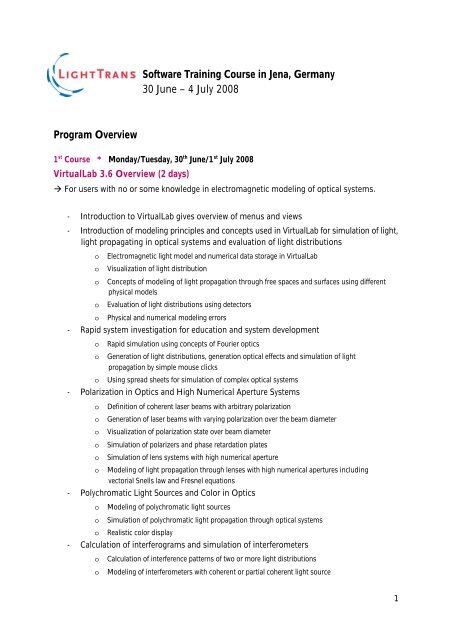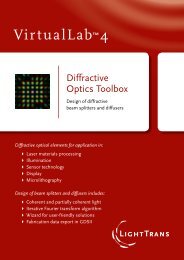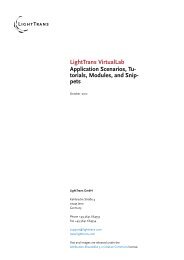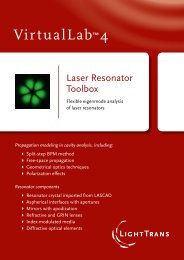Topics & schedule - LightTrans VirtualLab
Topics & schedule - LightTrans VirtualLab
Topics & schedule - LightTrans VirtualLab
You also want an ePaper? Increase the reach of your titles
YUMPU automatically turns print PDFs into web optimized ePapers that Google loves.
Program Overview<br />
Software Training Course in Jena, Germany<br />
30 June – 4 July 2008<br />
1 st Course * Monday/Tuesday, 30 th June/1 st July 2008<br />
<strong>VirtualLab</strong> 3.6 Overview (2 days)<br />
� For users with no or some knowledge in electromagnetic modeling of optical systems.<br />
- Introduction to <strong>VirtualLab</strong> gives overview of menus and views<br />
- Introduction of modeling principles and concepts used in <strong>VirtualLab</strong> for simulation of light,<br />
light propagating in optical systems and evaluation of light distributions<br />
o Electromagnetic light model and numerical data storage in <strong>VirtualLab</strong><br />
o Visualization of light distribution<br />
o Concepts of modeling of light propagation through free spaces and surfaces using different<br />
physical models<br />
o Evaluation of light distributions using detectors<br />
o Physical and numerical modeling errors<br />
- Rapid system investigation for education and system development<br />
o Rapid simulation using concepts of Fourier optics<br />
o Generation of light distributions, generation optical effects and simulation of light<br />
propagation by simple mouse clicks<br />
o Using spread sheets for simulation of complex optical systems<br />
- Polarization in Optics and High Numerical Aperture Systems<br />
o Definition of coherent laser beams with arbitrary polarization<br />
o Generation of laser beams with varying polarization over the beam diameter<br />
o Visualization of polarization state over beam diameter<br />
o Simulation of polarizers and phase retardation plates<br />
o Simulation of lens systems with high numerical aperture<br />
o Modeling of light propagation through lenses with high numerical apertures including<br />
vectorial Snells law and Fresnel equations<br />
- Polychromatic Light Sources and Color in Optics<br />
o Modeling of polychromatic light sources<br />
o Simulation of polychromatic light propagation through optical systems<br />
o Realistic color display<br />
- Calculation of interferograms and simulation of interferometers<br />
o Calculation of interference patterns of two or more light distributions<br />
o Modeling of interferometers with coherent or partial coherent light source<br />
1
2 nd Course * Wednesday 2 nd July 2008<br />
Micro and Diffractive Optics and Design of Diffractive Beam Splitters<br />
� Knowledge in Fourier Optics recommended.<br />
- Diffraction at arbitrary apertures and mask<br />
o Simulation of diffraction at arbitrary apertures and masks<br />
o Generation of aperture and mask data by <strong>VirtualLab</strong><br />
o Import of aperture and mask data from ASCII and bitmap files<br />
- Grating Toolbox: Diffraction at gratings and arrays of elements<br />
o Simulation of diffraction at gratings and arrays of elements (for example lens arrays)<br />
o Generation of periodic structures and transmission with arbitrary height profile<br />
o Rigorous and approximated models for simulation of diffraction effects at gratings.<br />
- Scattering on rough surfaces (import of measurement data)<br />
o Simulation of scattering at rough surfaces<br />
o Import of measured surface data from ASCII and bitmap files.<br />
- Diffractive Optics Toolbox: Design of diffractive beam splitting systems<br />
o Introduction to applications, typical setups and physical concepts of diffractive beam<br />
splitting systems<br />
o Selection of physical parameters of beam splitting system<br />
o Introduction to Iterative Fourier Transform Algorithm used for the design of diffractive<br />
optical elements<br />
o Design of diffractive beam splitting elements by Iterative Fourier Transform Algorithm<br />
o Advanced Design: optimizing elements with compromises between different merit<br />
functions<br />
o Generation of fabrication data<br />
3rd Course * Thursday 3 rd July 2008<br />
Laser Optics and Design of Laser Beam Shaping Systems<br />
� Knowledge in Fourier Optics and electromagnetic modeling of optical systems recommended.<br />
- Modeling of coherent laser beams including import of measurement data<br />
- Modeling of multimode laser by different higher order modes<br />
- Simulation of laser beam propagation through optical systems including diffraction effects,<br />
lens aberrations, and Fresnel losses<br />
- Evaluation of laser beam parameters<br />
- Beam Shaping Toolbox: Design of diffractive beam shaping systems<br />
o Introduction to applications, typical setups and physical concepts of diffractive beam<br />
shaping systems<br />
2
o Selection of physical parameters of beam shaping system<br />
o Design of diffractive beam shaping elements by Iterative Fourier Transform Algorithm<br />
o Advanced Design: optimizing elements with compromises between different merit<br />
functions<br />
o Generation of fabrication data<br />
- Beam Shaping Toolbox: Design of refractive beam shaping systems<br />
o Optimization of refractive beam shaping elements for fabrication by lithographic methods<br />
o Design of refractive beam shaping elements by Iterative Fourier Transform Algorithm<br />
o Generation of fabrication data<br />
4 th Course * Friday 4 th July 2008<br />
Homogenization of Laser and LED Light<br />
� Knowledge in Fourier Optics and electromagnetic modeling of optical systems recommended.<br />
- Simulation of optical Systems with partial coherent light sources as for example LED’s<br />
Excimer lasers<br />
o Introduction to electromagnetic modeling of partial coherent light sources by<br />
decomposition in modes<br />
o Partial coherent light source model used of <strong>VirtualLab</strong><br />
o Propagation of partial coherent light through optical systems<br />
o Evaluation of merit functions for partial coherent light<br />
o Modeling accuracy of partial coherent light sources<br />
- Simulation of homogenization system with lens arrays or diffractive diffusers<br />
o The simulation of lens array homogenization system is discussed on an example<br />
o The simulation of homogenization systems basing on diffractive diffusers is discussed on<br />
an example<br />
- Diffractive Optics Toolbox: Design of diffractive diffusers for light homogenization and<br />
pattern generation<br />
o Introduction to applications, typical setups and physical concepts of diffractive light<br />
diffusing systems<br />
o Selection of physical parameters of light diffusing system<br />
o Introduction to Iterative Fourier Transform Algorithm used for the design of diffractive<br />
diffusers<br />
o Design of diffractive diffusers by Iterative Fourier Transform Algorithm<br />
o Advanced Design: optimizing elements with compromises between different merit<br />
functions<br />
o Generation of fabrication data<br />
3









